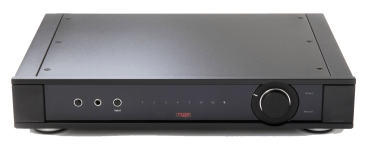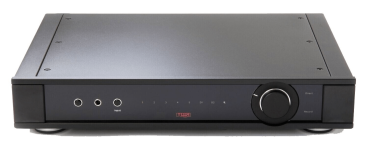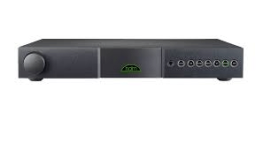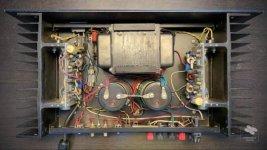One is Rega’s Elicit the others Arcam’s SA20 and a Naim XS3. What are you learned members here thinking of circuit layout and component quality? Which one would you choose?






Attachments
Last edited:
If you DIY, it will sound and look better than these. Guaranteed.
You want a judgement on sound quality based on these pictures? Amazing.
Jan
Jan
Without thinking twice, I choose REGA without any hesitation. Why? Quite simply because I like REGA. And the actual circuit is a great one.
HBt.
HBt.
I think that with a driver like Lme49830 or chipamp you could have something really good without being really hard,Beyond my capabilities for the moment but thank you JA.
with the LME49830 for sure better specs I do have severall diy modules if you want to have look check here:
https://www.ebay.de/usr/rocksandsound
Judging books by their covers 🙂 Also what is it to you what others think? Possibly the others like to see the brand name and declare that to be good (without knowing the competitors). Or some think black toroids are sexy so the amplifier may be good. In one I see too small heatsinks, another one has cartloads of tantalum caps (excellent but expensive) and at least one does not have speaker protection (this is really a requirement). One has relays for input selection which is also very nice. Or something bad like mediocre connectors, features over quality, wires soldered directly to boards... So all in all they all have something good and something not so good. None has all good and none has all bad. Judged by the looks and by technical properties helped by repair experience.....
Best is to listen to the device you listened to with your eyes but then now by ears. If you care about quality/longevity and as least features as possible then look elsewhere. My system is to define what I desire technically (relays as these add nothing, nothing superfluous, integrated, protection, internal PSU, preferably no SMPS/BT/Wireless/displays) and then look/listen. If what I think is good technically turns out to be too expensive or simply sounds so so I just order a new minimalist chinese amplifier with at least 50% of my wishes fulfilled without having ever listened to it and test and modify that one to my likings 😀 In many cases a basic cheapo outperforms way more expensive stuff and the "gamble and win" factor is nice. The fact that you can gamble and win (versus the supposedly better thoughtful choosing/listening, reading magazines, asking opinions on fora, reading reviews, postponing and reevaluating) says something.
Best is to listen to the device you listened to with your eyes but then now by ears. If you care about quality/longevity and as least features as possible then look elsewhere. My system is to define what I desire technically (relays as these add nothing, nothing superfluous, integrated, protection, internal PSU, preferably no SMPS/BT/Wireless/displays) and then look/listen. If what I think is good technically turns out to be too expensive or simply sounds so so I just order a new minimalist chinese amplifier with at least 50% of my wishes fulfilled without having ever listened to it and test and modify that one to my likings 😀 In many cases a basic cheapo outperforms way more expensive stuff and the "gamble and win" factor is nice. The fact that you can gamble and win (versus the supposedly better thoughtful choosing/listening, reading magazines, asking opinions on fora, reading reviews, postponing and reevaluating) says something.
Last edited:
I like the wiring of the Naim - someone really had some thoughts about the construction and wiring in advance, and did't add any flying cables as an afterthought.
But - you just can't judge the quality by looking at a picture.
But - you just can't judge the quality by looking at a picture.
No but I do value the accumulated knowledge on here. The question is simply about the circuits and design/parts. As a not-yet DIY'er I am just interested in opinions of those in the know.You want a judgement on sound quality based on these pictures? Amazing.
Jan
For example. I can see the Naim and Arcam have their torroids further away from the pre-amplifier circuits than the Rega. I understand this sort of transformer has less stray interference sideways, mostly up? Does that matter in the case of these integrated amplifiers? The Arcam doesn't use a 'conventional' volume pot such as the Alps on the other two? Which one is preferable or does it not matter much?
I (think) I can also see that the Naims analogue RCA inputs are on a separate board and connected to the main board with what seems a multi cable similar to those used in computers and such and connected to the main board through connectors. Are there disadvantages in doing so?
The Rega has what looks like a separated output stage, left and right with their own respective heat sinks. Is that good design and could that possibly make a difference to sound in a positive way? It's certainly more expensive to add two heat sinks.
Thank you
Last edited:
That knowledge may be useful to predict repairs and negative influence of design and budget choices. It may lead to choosing a device technically well designed that never breaks down but sounds so so to you. The combination of good parts may not always lead to success and cheap stuff sometimes leads to success. The latter is IMHO way more pleasant.
There was a tremendous amplifier in the past that had a large non standard sliding volume potentiometer. Guess what was THE failure mode.
And yes wiring, band cable and internal connectors are to be avoided. Modular designing leads to such. Many modern products are designed in this Lego style and it is often technically inferior and weak.
There was a tremendous amplifier in the past that had a large non standard sliding volume potentiometer. Guess what was THE failure mode.
And yes wiring, band cable and internal connectors are to be avoided. Modular designing leads to such. Many modern products are designed in this Lego style and it is often technically inferior and weak.
Last edited:
I guess you are putting too much into this.
Commercial products are built to a price. Let's say if the BOM is above 200 EUR (and a targeted sales price of 1499 EUR), you either have to cut down some components costs or raise the SRP. So that's the reason you are seeing different features - for sure these manufacturers (with decades of experience) know, input relays are a good idea - but there was no budget left, so no, use something cheaper.
Probably the greatest advantage of DIY - if you add 10 relays at 1 EUR each, it just costs you 10 EUR more - but a professional manufacturer needs to move the machine to a higher market segment due to raised BOM/sales price, and that might not be competive any more.
Commercial products are built to a price. Let's say if the BOM is above 200 EUR (and a targeted sales price of 1499 EUR), you either have to cut down some components costs or raise the SRP. So that's the reason you are seeing different features - for sure these manufacturers (with decades of experience) know, input relays are a good idea - but there was no budget left, so no, use something cheaper.
Probably the greatest advantage of DIY - if you add 10 relays at 1 EUR each, it just costs you 10 EUR more - but a professional manufacturer needs to move the machine to a higher market segment due to raised BOM/sales price, and that might not be competive any more.
Sad really, the number of components that I have owned, where the layout and wiring were stunning in appearance, but the sound was not. As stated, there are components out there that shouldn't sound as good as they do, at least by the looks of them. DIY has been the blessing of having a better chance of getting what you like to see and hear.
OK, but it isn't for grabs when it comes to commercial product - this is just not that kind of forum. We build things here and you should try that too... the other forum does this....No but I do value the accumulated knowledge on here.
//
Nonsense, ready made and modification of ready made are just as welcome. Asking opinions on various ready made devices is less common though but AFAIK there is no law against it. Before you know it one would experience discrimination because of liking class D or whatever.
This particular year the cost difference between DIY and ready made has become quite high. Too high maybe, my guess is at least a factor 2. Part availibility is deteriorating. Also DIY is not a guarantee for best results either. Some projects lack essential features and resemble My First DIY Project. If the goal is highest quality it may today be the first and tomorrow the latter.
One has to evaluate and just make a choice.
This particular year the cost difference between DIY and ready made has become quite high. Too high maybe, my guess is at least a factor 2. Part availibility is deteriorating. Also DIY is not a guarantee for best results either. Some projects lack essential features and resemble My First DIY Project. If the goal is highest quality it may today be the first and tomorrow the latter.
One has to evaluate and just make a choice.
Last edited:
You want a judgement on sound quality based on these pictures? Amazing. 😎No but I do value the accumulated knowledge on here. The question is simply about the circuits and design/parts. As a not-yet DIY'er I am just interested in opinions of those in the know.
For example. I can see the Naim and Arcam have their torroids further away from the pre-amplifier circuits than the Rega. I understand this sort of transformer has less stray interference sideways, mostly up? Does that matter in the case of these integrated amplifiers? The Arcam doesn't use a 'conventional' volume pot such as the Alps on the other two? Which one is preferable or does it not matter much?
I (think) I can also see that the Naims analogue RCA inputs are on a separate board and connected to the main board with what seems a multi cable similar to those used in computers and such and connected to the main board through connectors. Are there disadvantages in doing so?
The Rega has what looks like a separated output stage, left and right with their own respective heat sinks. Is that good design and could that possibly make a difference to sound in a positive way? It's certainly more expensive to add two heat sinks.
Thank you
Jan
The second and third ones have most of the weight on one side, which increases the chance of mishaps during handling. An expensive amp hitting the ground sounds awful. They also both have large electrolytic capacitors too close to the main heatsinks. Prematurely failing capacitors certainly don't sound good.
Even as I am interested in class G/H , those Arcams look like a bunch of non-servicable junk that will end up in landfill.
if you become dissatisfied with any individual section , or it fails. You are stuck with the same "boat anchor".
Class G is also allowing them to cut corners on heatsinks , ventilation , and power supplies.
The Niam is really pushing the heatsink/efficiency curve - bet it has a cpu thermal shutdown and other frills - instead of just
using some more metal. NO overbuilding on any of these amps.
Bet the rails are just 3-4V below the cap ratings , as well.
Give me a separate amp any day , I can choose (or replace) any of my pre/source electronics at will.
This is why I like the Haflers , old adcoms (GFA-xxx) , my sonance.
Just get a plain amp , add a dac/preamp - all done.
OS
if you become dissatisfied with any individual section , or it fails. You are stuck with the same "boat anchor".
Class G is also allowing them to cut corners on heatsinks , ventilation , and power supplies.
The Niam is really pushing the heatsink/efficiency curve - bet it has a cpu thermal shutdown and other frills - instead of just
using some more metal. NO overbuilding on any of these amps.
Bet the rails are just 3-4V below the cap ratings , as well.
Give me a separate amp any day , I can choose (or replace) any of my pre/source electronics at will.
This is why I like the Haflers , old adcoms (GFA-xxx) , my sonance.
Just get a plain amp , add a dac/preamp - all done.
OS
Attachments
- Home
- Amplifiers
- Solid State
- Circuits and quality



